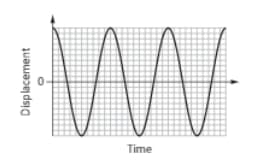Consider a string with both ends fixed. A standing wave in the second harmonic mode is established on the string, as shown in the diagram. 
Consider the vibrations of two points on the string, P and Q. The displacement of point P is given by the equation where in and is in seconds. State the phase difference between the oscillation of point P and that of point Q. Hence write down the equation giving the displacement of point Q.


Important Questions on Waves
A horizontal aluminium rod of length is hit sharply with a hammer. The hammer rebounds from the rod later. Explain why the hammer rebounds.
A horizontal aluminium rod of length is hit sharply with a hammer. The hammer rebounds from the rod later. Calculate the speed of sound in aluminium.
A horizontal aluminium rod of length is hit sharply with a hammer. The hammer rebounds from the rod later. Calculate the speed of sound in aluminium. The hammer created a longitudinal standing wave in the rod. Estimate the frequency of the sound wave by assuming that the rod vibrates in the first harmonic.
The diagram shows a print P on a string at a particular instant of time. A transverse wave is travelling along the string from left to right.
Which is correct about the direction and the magnitude of the velocity of point P at this instant?
The graph shows the displacement of a medium when a longitudinal wave travels through the medium from left to right. Positive displacements correspond to motion to the right. Which point corresponds to the centre of the compression?
The graph shows the variation with the time of the displacement of a particle in a medium when a wave of intensity I travel through the medium. The Intensity of the wave is halved. Which graph now represents the variation of displacement with time? (The scale on all graphs is the same.)



